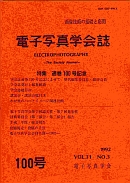Volume 37, Issue 1
Displaying 1-17 of 17 articles from this issue
- |<
- <
- 1
- >
- >|
Special Issues
-
1998Volume 37Issue 1 Pages 3-9
Published: 1998
Released on J-STAGE: March 22, 2007
Download PDF (1255K) -
1998Volume 37Issue 1 Pages 10-15
Published: 1998
Released on J-STAGE: March 22, 2007
Download PDF (2120K) -
1998Volume 37Issue 1 Pages 16-24
Published: 1998
Released on J-STAGE: March 22, 2007
Download PDF (2658K) -
1998Volume 37Issue 1 Pages 25-30
Published: 1998
Released on J-STAGE: March 22, 2007
Download PDF (1312K) -
1998Volume 37Issue 1 Pages 31-39
Published: 1998
Released on J-STAGE: March 22, 2007
Download PDF (4950K)
Regular Papers
-
1998Volume 37Issue 1 Pages 40-47
Published: 1998
Released on J-STAGE: March 22, 2007
Download PDF (1037K) -
1998Volume 37Issue 1 Pages 48-52
Published: 1998
Released on J-STAGE: March 22, 2007
Download PDF (1823K) -
1998Volume 37Issue 1 Pages 53-57
Published: 1998
Released on J-STAGE: March 22, 2007
Download PDF (875K) -
1998Volume 37Issue 1 Pages 58-66
Published: 1998
Released on J-STAGE: March 22, 2007
Download PDF (1104K) -
1998Volume 37Issue 1 Pages 67-73
Published: 1998
Released on J-STAGE: March 22, 2007
Download PDF (782K)
Comment
-
1998Volume 37Issue 1 Pages 74-77
Published: 1998
Released on J-STAGE: March 22, 2007
Download PDF (740K)
Technical Review
-
1998Volume 37Issue 1 Pages 79-89
Published: 1998
Released on J-STAGE: March 22, 2007
Download PDF (3780K)
Imaging Today
“Technical movements for irradiating device”
“Technical movements for irradiating device”
-
1998Volume 37Issue 1 Pages 91-98
Published: 1998
Released on J-STAGE: March 22, 2007
Download PDF (2418K) -
1998Volume 37Issue 1 Pages 99-104
Published: 1998
Released on J-STAGE: March 22, 2007
Download PDF (1800K) -
1998Volume 37Issue 1 Pages 105-110
Published: 1998
Released on J-STAGE: March 22, 2007
Download PDF (1894K) -
1998Volume 37Issue 1 Pages 111-117
Published: 1998
Released on J-STAGE: March 22, 2007
Download PDF (2029K) -
1998Volume 37Issue 1 Pages 118-120
Published: 1998
Released on J-STAGE: March 22, 2007
Download PDF (699K)
- |<
- <
- 1
- >
- >|
